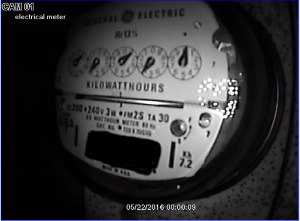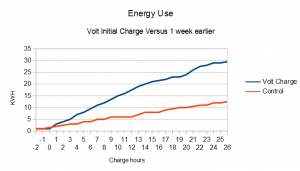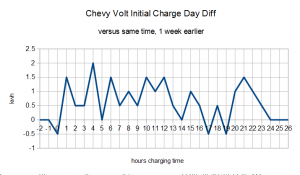A funny thing about the exciting adventure of ordering a car — I actually had enough time to lose interest. We sat down with Billy at JN Chevrolet and did the order — or rather claimed one of their orders — on April 8th, and the car was delivered on May 28. So during that 50 days, I had time to sort of back-burner the whole Volt thing. Mind you, I had not been idle. I oversaw the installation of a new 120 V GFCI electrical outlet, on its own circuit, I began taking regular meter readings from the electric company’s meter, and I thought an awful lot about electric cost versus gas cost.
Why Buy An Electric Car?
Because, first and foremost, it has the potential to save money on operational costs. In Hawaii, the comparison of electrical versus gasoline used to drive to work is going to be a close thing. In the US mainland, it’s a bigger win, but in Hawaii, it’s looking like electric wins the cost picture “by a nose”, more data on that going forward. But with electric, you have the potential to reduce fuel costs to zero, with solar. Granted, that investment would be hard to justify on cost basis alone, but it’s not an option with an ICE-only platform.
Also because carbon output. I always roll my eyes when I see the “Zero Emissions” label on Nissan Leaf, since, unless they’ve got a 2 KW solar installation at home, it’s simply not so. Still, consider that your power company will generate less carbon emissions than your ICE engine to produce the same kWh of energy, and for every electric car, emissions improvements by the power company mean less emissions per mile driven. Also consider that when petroleum prices rise, your gas price rises more with price-per-barrel than your electric kWh price does, probably. So electric car is more rising-cost-of-petroleum friendly.
Also — and if I were honest, this might really be reason #1 – it’s a F**KING ELECTRIC CAR, dude. How cool is that?
[It seems that it is necessary to clarify that Chevy Volt operates primarily as an electric vehicle. There are many who would argue that Chevy has mis-categorized it, or lied about how it works, but the fact is that when the battery is within 9 kWh of a full charge, it will not use any gas. Calling it a “plug in hybrid” is probably valid, saying that Chevy misrepresents it for some nefarious purpose is barking at the moon. I stand by “electric car” as a description for Chevy Volt. ]
Why Buy Chevy Volt?
I settled on Volt initially because it’s logistically elegant. When the dealer handed me the key, the battery charge was at 0%. I got in, and drove over a mountain range to home, with plenty of oomph over the hill to stay on the left and keep up with the passing crowd. I got, according to the summary provided by Volt itself, 33 MPG with the on-board gas-burning power plant providing power. Meaning that 2017 Chevy Volt a peppy, efficient, comfortable car, even without battery power. Can’t do that with a Nissan Leaf. Also, I can charge it each day in about 7 hours, and use no gas to commute to work, saving money in the process. Can’t do that with a Toyota Prius (Toyota discontinued their plug-in hybrid temporarily, it seems, otherwise they could compete at this).
Two other things you can do with a Volt that you can’t do with a Toyota Prius are:
– get a $7500 tax credit from the U.S. Government.
– park at county and State facilities for free.
And since Volt is selling briskly, alongside Leaf and etc, the end of incentives may be approaching faster than previously predicted.
Also, it’s an awesome-nice car. I mean nice in a meaningful way, not in the ways that people seem to rationalize worthless expense. It’s comfortable, and I like the look of it. It does suffer from a slight dose of the Conspicuous Conservation Syndrome** but mostly it looks like a 2017 Chevy. I have to look for clues to tell it apart from a 2016 Cruze, or Malibu. That makes me happy.
Value Of Time-Of-Use Electrical Metering
I spent some time looking into whether HECO’s TOU metering rates were worth the trouble. The gist is this – you pay:
– 5.5 cents more per kWh during peak times (M-F, 5PM to 9 PM)
– 2.5 cents more per kWh during mid-peak times (M-F, 7AM to 5 PM, S-S 7AM-9PM)
– 6 cents less during off-peak (7 days, 9 PM to 7AM)
Which means that you get a discount during the normal EV charging time, but you need a strategy for doing laundry or other big-energy activities at night, or pay more for it. If you can line-dry clothes, solar heat your water, then TOU may work in your favor, but it’s a bit of a wash (unintended pun) either way. For us, the decision seems to come down to paying $5 or $10 dollars per month to avoid the annoyance of avoiding peak-rate electrical use (we have solar hot water). Plus, that 8 hours of cheap energy per night might not be enough to feed the car, so the non-TOU option allows more freedom to do a catch-up charge on the weekend.
How did I evaluate the benefits of TOU? I did buy parts for the Open Energy Monitor a month ago, but life being what it is, I haven’t got it set up yet. As a stop-gap I took an extra security camera and connected it up to the home security DVR, to record the electric company’s meter, 24 hours a day. This has proven to be a really handy thing.
 I made a spreadsheet with readings from the meter at 7 AM, 5 PM, and 9 PM over the course of a month. Considering the cost differences and introducing a car charge estimate of 8.5 kWh on commute days and 5 kWh on weekends, TOU would save about $0.28 per day, or about $8.53 a month.
I made a spreadsheet with readings from the meter at 7 AM, 5 PM, and 9 PM over the course of a month. Considering the cost differences and introducing a car charge estimate of 8.5 kWh on commute days and 5 kWh on weekends, TOU would save about $0.28 per day, or about $8.53 a month.
You could increase the TOU advantage with some behavioral changes, but the level of cost and the desirability of the changes, and the ROI pay-off to offset the new meter installation gives me pause.
The Initial Charge
As I said above, the car was delivered with the battery at 0% charge, so it was necessary to do a full charge at home. I got it started at about 4:35 PM on Friday (sorry HECO, but no TOU), and charged with an 8 amp limit for about 16 hours, paused for a while and began the charge again with 12 amp limit for another 2 hours.
Comparing my readings from Friday/Saturday one week earlier, the full charge appears to have used about 17 kWh.
 As of this writing, it remains to be seen how much the commute, with its trip over the Ko’ola’u Mountains, will cost me, but in mileage terms alone, it would be about 9.6 kWh per day, based on Chevy-provided figures, but when has OEM new car mileage ever played out in real life? At a gas price of $2.50 and a kWh price of $0.29, the number of kWh to beat is about 8.6 kWh per commute*. It might actually be cheaper to commute in the Volt with gas. But not by much. There are other factors to consider.
As of this writing, it remains to be seen how much the commute, with its trip over the Ko’ola’u Mountains, will cost me, but in mileage terms alone, it would be about 9.6 kWh per day, based on Chevy-provided figures, but when has OEM new car mileage ever played out in real life? At a gas price of $2.50 and a kWh price of $0.29, the number of kWh to beat is about 8.6 kWh per commute*. It might actually be cheaper to commute in the Volt with gas. But not by much. There are other factors to consider.
After the drive home from the dealer, Volt produced the sobering statistic that 32% of my energy had been spent on climate control. It may be that driving with the windows open would be a big energy saver. Also, there’s the matter of the regen-on-demand paddle. This control, which is under your left-hand fingertips when you have your hands on the steering wheel, causes Volt to convert momentum into battery charge when pressed, effectively causing braking in the process. On the downhill side of the mountains, one can choose between driving faster or saving money. Hmmmm.
If you can believe it, after getting through the 18 hour charge, I still didn’t find a reason to go drive the new electric car in the day and a half since I got it home. I will try to do better in the future.
Hopefully, I will get more-better numbers on the economy of Volt in the coming weeks. Stay tuned.
*competing with previous car 2013 Toyota Corolla, which gets about 30 MPG on my 30-mile round-trip commute, according to many odometer-versus-gas-pump calculations.
** to enjoy Freakonomics Radio podcast in your electric car, see:
http://freakonomics.com/archive/
or
http://www.podcastone.com/Freakonomics-Radio?showAllEpisodes=true
for mp3 downloads.
Also — Guest commentator Tim Harford’s “More Or Less” podcast from BBC Radio


